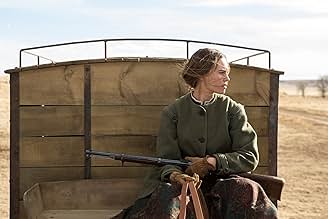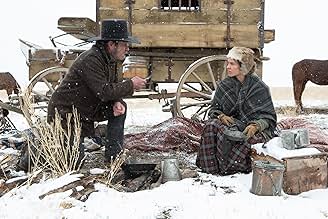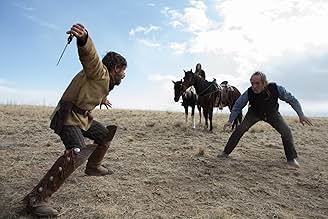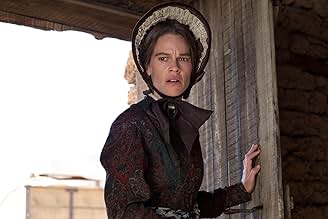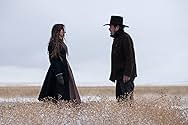Tres mujeres son transportadas a través del país en un vagón por la piadosa e independiente Mary Bee Cuddy, quien a su vez emplea al vagabundo George Briggs para que la ayude.Tres mujeres son transportadas a través del país en un vagón por la piadosa e independiente Mary Bee Cuddy, quien a su vez emplea al vagabundo George Briggs para que la ayude.Tres mujeres son transportadas a través del país en un vagón por la piadosa e independiente Mary Bee Cuddy, quien a su vez emplea al vagabundo George Briggs para que la ayude.
- Dirección
- Guionistas
- Elenco
- Premios
- 5 premios ganados y 14 nominaciones en total
Opiniones destacadas
'THE HOMESMAN': Four and a Half Stars (Out of Five)
Tommy Lee Jones directed, co-wrote and stars in this western/drama film (set in the 1850s midwest) about a 'spinster' and a 'drifter' transporting three women, driven mad by the hardships of the time, across the country. It costars Hilary Swank, Miranda Otto, Grace Gummer and Sonja Richter. It also features cameos by Meryl Streep, John Lithgow, James Spader, Tim Blake Nelson, William Fichtner and Hailee Steinfeld. The film was written by Jones, Kieran Fitzgerald and Wesley Oliver and it's based on the 1988 novel, of the same name, by Glendon Swarthout. French filmmaker Luc Besson served as a producer of the movie and it also features a breathtaking music score by Marco Beltrami. It's surprisingly dark, and extremely disturbing, but I enjoyed it due to it's strong character development, outstanding performances and odd beauty.
Swank plays Mary Bee Cuddy, a strong and independent 31-year-old woman from New York. She desperately wants to find a husband but can't, due to men finding her too plain looking (I don't think Swank looks bad at all in this movie, considering the film's time and setting). When the local reverend (Lithgow) asks for someone to transport three women across the country, to a church in Hebron Iowa, Cuddy volunteers. The women (Otto, Gummer and Richter) are all mentally ill and the church will provide the special help they need. Cuddy comes across a drifter named George Briggs (Jones), who's about to be lynched for 'claim jumping', and asks him for his help (in return for saving his life). The two make the long journey together and form an odd bond.
The movie has been called a 'feminist western', by many, and I'd definitely agree it's a strong female character study, about the hardships women faced at the time. Swank is outstanding in the co- lead and Jones is just as classic and tough as ever; he does (unintentionally I think) steal some of the female cast's thunder. Jones also proves he's an equally talented director (once again) and the movie is full of beautiful visuals, as well as haunting imagery. For me the highlight of the film is the beautiful music and the touching relationships formed by the movie's central characters (it also has a shocking and unexpected twist, at the end of the second act). It's a hard film to watch, at times, but definitely worth it; if you're a fan of the genre or even if you're not.
Watch our movie review show 'MOVIE TALK' at: http://youtu.be/1_bZp5ejQ4I
Tommy Lee Jones directed, co-wrote and stars in this western/drama film (set in the 1850s midwest) about a 'spinster' and a 'drifter' transporting three women, driven mad by the hardships of the time, across the country. It costars Hilary Swank, Miranda Otto, Grace Gummer and Sonja Richter. It also features cameos by Meryl Streep, John Lithgow, James Spader, Tim Blake Nelson, William Fichtner and Hailee Steinfeld. The film was written by Jones, Kieran Fitzgerald and Wesley Oliver and it's based on the 1988 novel, of the same name, by Glendon Swarthout. French filmmaker Luc Besson served as a producer of the movie and it also features a breathtaking music score by Marco Beltrami. It's surprisingly dark, and extremely disturbing, but I enjoyed it due to it's strong character development, outstanding performances and odd beauty.
Swank plays Mary Bee Cuddy, a strong and independent 31-year-old woman from New York. She desperately wants to find a husband but can't, due to men finding her too plain looking (I don't think Swank looks bad at all in this movie, considering the film's time and setting). When the local reverend (Lithgow) asks for someone to transport three women across the country, to a church in Hebron Iowa, Cuddy volunteers. The women (Otto, Gummer and Richter) are all mentally ill and the church will provide the special help they need. Cuddy comes across a drifter named George Briggs (Jones), who's about to be lynched for 'claim jumping', and asks him for his help (in return for saving his life). The two make the long journey together and form an odd bond.
The movie has been called a 'feminist western', by many, and I'd definitely agree it's a strong female character study, about the hardships women faced at the time. Swank is outstanding in the co- lead and Jones is just as classic and tough as ever; he does (unintentionally I think) steal some of the female cast's thunder. Jones also proves he's an equally talented director (once again) and the movie is full of beautiful visuals, as well as haunting imagery. For me the highlight of the film is the beautiful music and the touching relationships formed by the movie's central characters (it also has a shocking and unexpected twist, at the end of the second act). It's a hard film to watch, at times, but definitely worth it; if you're a fan of the genre or even if you're not.
Watch our movie review show 'MOVIE TALK' at: http://youtu.be/1_bZp5ejQ4I
December 19, 2014
A homesman is someone tasked to bring people back to their homes. In this film, the people that needed safe transport are three mentally- disturbed women. Mary Bee McCuddy, a plain but hardy spinster, volunteered to be their homesman. Along the way, she rescues a old man Thomas Briggs from being hung by vigilantes and conscripts him to help her with her mission in exchange for saving his life. Together, they gather the three ladies and escort them from Nebraska homes across the dangerous Midwest prairie to a safe haven in Iowa.
Hilary Swank is an actress who had already won a couple of Oscars for playing strong women who had taken on masculine roles in life -- Brandon Teena in "Boys Don't Cry" and Maggie Fitzgerald in "Million Dollar Baby". As Mary Bee McCuddy, a pioneer lady who bravely accepts a task only men are expected to do, Swank again goes on the same award-baiting path. The movie worked so well when Swank was on screen. She was absolutely compelling in this offbeat role as if this was written with her in mind. The movie was not the same when her character was not there.
Tommy Lee Jones is one actor who, as of late, had seemingly been confined to playing curmudgeonly and cantankerous old men, and his Briggs here is not any different. This film is only Jones' second directorial effort since his critically-acclaimed debut in "Three Burials of Melquiades Estrada" back in 2005. As director, he was very generous to his lead female star Swank, and always gave way to let her shine. As actor, he does consistently as he is expected but this role of a grumpy old outlaw seems too familiar for him already. He wisely played Briggs with some self-deprecating humor to break the tendency of the story to become monotonously bleak.
There were some remarkable cameos from other award-winning or nominated stars in much smaller roles. John Lithgow is his usual capable self playing the Reverend Dowd who reluctantly sends McCuddy off on her task. Hailee Steinfeld plays 16-year old Tabitha Hutchinson to whom Briggs offers a surprising proposal. James Spader, in his usual over-the-top style, plays condescending hotel owner Aloysius Duffy. And last, but definitely not the least, none other than THE Meryl Streep plays perfectly kind and hospitable Altha Carter, who runs the institution in Iowa the women are headed for. These actors appear on screen for only ten minutes or so, but they leave a lasting impression.
The narrative may have been slow and desolate . However, the unusual situations, disturbing imagery, startling story developments and committed performances by the cast all keep our attention riveted. The cinematography with the muted colors worked well with the windswept landscape of its setting, as much a character in itself. The costumes and production design rang true to its mid-19th century time period. The haunting and unsettling musical score create an atmosphere of bitter emptiness. The insufferably miserable topic is clearly not for everyone. But for those who decide to give it a chance, the rewards will be satisfying. 7/10.
A homesman is someone tasked to bring people back to their homes. In this film, the people that needed safe transport are three mentally- disturbed women. Mary Bee McCuddy, a plain but hardy spinster, volunteered to be their homesman. Along the way, she rescues a old man Thomas Briggs from being hung by vigilantes and conscripts him to help her with her mission in exchange for saving his life. Together, they gather the three ladies and escort them from Nebraska homes across the dangerous Midwest prairie to a safe haven in Iowa.
Hilary Swank is an actress who had already won a couple of Oscars for playing strong women who had taken on masculine roles in life -- Brandon Teena in "Boys Don't Cry" and Maggie Fitzgerald in "Million Dollar Baby". As Mary Bee McCuddy, a pioneer lady who bravely accepts a task only men are expected to do, Swank again goes on the same award-baiting path. The movie worked so well when Swank was on screen. She was absolutely compelling in this offbeat role as if this was written with her in mind. The movie was not the same when her character was not there.
Tommy Lee Jones is one actor who, as of late, had seemingly been confined to playing curmudgeonly and cantankerous old men, and his Briggs here is not any different. This film is only Jones' second directorial effort since his critically-acclaimed debut in "Three Burials of Melquiades Estrada" back in 2005. As director, he was very generous to his lead female star Swank, and always gave way to let her shine. As actor, he does consistently as he is expected but this role of a grumpy old outlaw seems too familiar for him already. He wisely played Briggs with some self-deprecating humor to break the tendency of the story to become monotonously bleak.
There were some remarkable cameos from other award-winning or nominated stars in much smaller roles. John Lithgow is his usual capable self playing the Reverend Dowd who reluctantly sends McCuddy off on her task. Hailee Steinfeld plays 16-year old Tabitha Hutchinson to whom Briggs offers a surprising proposal. James Spader, in his usual over-the-top style, plays condescending hotel owner Aloysius Duffy. And last, but definitely not the least, none other than THE Meryl Streep plays perfectly kind and hospitable Altha Carter, who runs the institution in Iowa the women are headed for. These actors appear on screen for only ten minutes or so, but they leave a lasting impression.
The narrative may have been slow and desolate . However, the unusual situations, disturbing imagery, startling story developments and committed performances by the cast all keep our attention riveted. The cinematography with the muted colors worked well with the windswept landscape of its setting, as much a character in itself. The costumes and production design rang true to its mid-19th century time period. The haunting and unsettling musical score create an atmosphere of bitter emptiness. The insufferably miserable topic is clearly not for everyone. But for those who decide to give it a chance, the rewards will be satisfying. 7/10.
The Homesman, written and directed and starring Tommy Lee Jones tells the story of Mary Bee Cuddy (Hilary Swank) a spinster who takes on the responsibility of bringing three insane women to Iowa where they can be taken care of.
She saves or spares the life of George Briggs (Tommy Lee Jones) and enlists him on her arduous five week journey.
When you see Hilary Swank and Tommy Lee Jones, you know the acting is going to be stellar. The parts of the insane women, Arabella Sours (Grace Gummer), Theoline Belknapp (Miranda Otto), Gro Svendsen (Sonja Richter) because of the great directing remained the focus while being secondary characters. The movie had a Shakespearean feel to it and that is a great compliment. These ladies portrayed insanity, believably and that takes serious dedication and acting ability.
"The Homesman" was a tragedy and because of it, some people might not be able to pallet the story; there were some shocking attention grabbing scenes that the average viewer might not be prepared for. Those scenes, to me, were great examples of a different time, a time when life was hard and people died.
The Homesman is a story that sits with you and makes you thankful for many things, even if it just the shoes on your feet.
She saves or spares the life of George Briggs (Tommy Lee Jones) and enlists him on her arduous five week journey.
When you see Hilary Swank and Tommy Lee Jones, you know the acting is going to be stellar. The parts of the insane women, Arabella Sours (Grace Gummer), Theoline Belknapp (Miranda Otto), Gro Svendsen (Sonja Richter) because of the great directing remained the focus while being secondary characters. The movie had a Shakespearean feel to it and that is a great compliment. These ladies portrayed insanity, believably and that takes serious dedication and acting ability.
"The Homesman" was a tragedy and because of it, some people might not be able to pallet the story; there were some shocking attention grabbing scenes that the average viewer might not be prepared for. Those scenes, to me, were great examples of a different time, a time when life was hard and people died.
The Homesman is a story that sits with you and makes you thankful for many things, even if it just the shoes on your feet.
I need to get something off my chest: I'm not a fan of Tommy Lee Jones. I find him limited in range, much the same in most roles and, worst of all, he inexplicably won the Best Supporting Actor Oscar for The Fugitive, thus depriving Pete Postlethwaite for In the Name of the Father, Leonardo Di Caprio for What's Eating Gilbert Grape and Ralph Fiennes for his performance of pure evil as Amon Goeth in Schindler's List. In modern parlance, WTF?
But periodically, just occasionally, once in a while, he inhabits the screen in a manner that forces one to reconsider one's judgment. And so it is with The Homesman.
The Homesman is something of a surprise, and not just because Tommy Lee Jones is on remarkable form in it. Beyond a fine performance, the man writes, directs and co-produces it. Hell's bells, when did he become so damn good at everything?
In the bad old days of the pioneers in the Wild West, Mary Bee Cuddy (Hilary Swank) steps in when three women drift into various states of madness and need to be transported across the country to be cared for properly. Shunned by their husbands, denied help from the town's menfolk and at a time where rape and murder hides behind every outcrop of rock and every gnarled cactus, Cuddy sets off alone on her hazardous journey. She stumbles across George Briggs (Tommy Lee Jones), a drifter seated atop his horse, with a noose around his neck, waiting for his steed to grow bored and leave him hanging. Literally. Cuddy offers to save him on the condition that he accompanies her and so begins a particular kind of journey.
The Homesman is probably described by many as a western, but that's lazy. This is a road movie on horseback, a saunter across the plains, a journey through mistrust and emotions where a mistake or misplaced trust will result in death. It is a story of hope and love, not the romantic kind, but real love for one's fellow human being, regardless of whether they can, or will, reciprocate.
Shot beautifully with sprawling, dusty vistas that warm the heart and prickle the nape, the backdrop is a vast canvas of character and mystery upon which splashes of colour are smeared in the shape of wandering, human dangers.
Though they say little, the trio of women (Grace Gummer, Miranda Otto and Sonja Richter) are far more than peripheral characters or the MacGuffin; they are the substance that binds The Homesman and the reason for the drama, gentle though it is. As we saw in Mr. Turner, such characters can so easily become pantomime animals with over performance that slaps the viewer in the face and detracts from the whole, of which they are but a small part. Not so here. Grace Gummer, particularly, as the mostly mute but vacantly animated Arabella is terrific and we want to reach into the screen and gently push her back towards sanity. It is a beautiful, understated performance that remains in mind long after the event.
Tommy Lee Jones and Hilary Swank make a surprising double act but the chemistry is there in abundance. Both Cuddy and Briggs carry their own needs and daemons with them; neither would give the other a second glance ordinarily but circumstance prompts odd, emotional couplings and theirs is fraught with suspicion and obligation. It is fantastic to see Swank back to the form that brought her gongs and made us sit up and watch in Boys Don't Cry and Million Dollar Baby. This is a far less demonstrative performance, but no less steely or impactful because of it.
Tommy Lee Jones's performance is the most compelling, engrossing that I can recall. Beyond that, his direction is worth celebrating loudly. The Homesman is only his second feature as director (after 2006's wonderful but little seen The Three Burials of Melquiades Estrada) but there are hints that he may step into Clint Eastwood's shoes alongside Ben Affleck and Sean Penn. Just when we think we have the measure of this tale, he belts us sharply around the jowls, proving he has the mettle to surprise and shock us out of our complacency.
Maybe, after years and years of apparently coasting, broodily on film and staring into space, it will transpire he was merely absorbing, waiting for the moment to own both sides of the screen and captivate us.
You know what, maybe he's always been this good but I just didn't see it.
For more reviews from The Squiss, subscribe to my blog and like the Facebook page.
But periodically, just occasionally, once in a while, he inhabits the screen in a manner that forces one to reconsider one's judgment. And so it is with The Homesman.
The Homesman is something of a surprise, and not just because Tommy Lee Jones is on remarkable form in it. Beyond a fine performance, the man writes, directs and co-produces it. Hell's bells, when did he become so damn good at everything?
In the bad old days of the pioneers in the Wild West, Mary Bee Cuddy (Hilary Swank) steps in when three women drift into various states of madness and need to be transported across the country to be cared for properly. Shunned by their husbands, denied help from the town's menfolk and at a time where rape and murder hides behind every outcrop of rock and every gnarled cactus, Cuddy sets off alone on her hazardous journey. She stumbles across George Briggs (Tommy Lee Jones), a drifter seated atop his horse, with a noose around his neck, waiting for his steed to grow bored and leave him hanging. Literally. Cuddy offers to save him on the condition that he accompanies her and so begins a particular kind of journey.
The Homesman is probably described by many as a western, but that's lazy. This is a road movie on horseback, a saunter across the plains, a journey through mistrust and emotions where a mistake or misplaced trust will result in death. It is a story of hope and love, not the romantic kind, but real love for one's fellow human being, regardless of whether they can, or will, reciprocate.
Shot beautifully with sprawling, dusty vistas that warm the heart and prickle the nape, the backdrop is a vast canvas of character and mystery upon which splashes of colour are smeared in the shape of wandering, human dangers.
Though they say little, the trio of women (Grace Gummer, Miranda Otto and Sonja Richter) are far more than peripheral characters or the MacGuffin; they are the substance that binds The Homesman and the reason for the drama, gentle though it is. As we saw in Mr. Turner, such characters can so easily become pantomime animals with over performance that slaps the viewer in the face and detracts from the whole, of which they are but a small part. Not so here. Grace Gummer, particularly, as the mostly mute but vacantly animated Arabella is terrific and we want to reach into the screen and gently push her back towards sanity. It is a beautiful, understated performance that remains in mind long after the event.
Tommy Lee Jones and Hilary Swank make a surprising double act but the chemistry is there in abundance. Both Cuddy and Briggs carry their own needs and daemons with them; neither would give the other a second glance ordinarily but circumstance prompts odd, emotional couplings and theirs is fraught with suspicion and obligation. It is fantastic to see Swank back to the form that brought her gongs and made us sit up and watch in Boys Don't Cry and Million Dollar Baby. This is a far less demonstrative performance, but no less steely or impactful because of it.
Tommy Lee Jones's performance is the most compelling, engrossing that I can recall. Beyond that, his direction is worth celebrating loudly. The Homesman is only his second feature as director (after 2006's wonderful but little seen The Three Burials of Melquiades Estrada) but there are hints that he may step into Clint Eastwood's shoes alongside Ben Affleck and Sean Penn. Just when we think we have the measure of this tale, he belts us sharply around the jowls, proving he has the mettle to surprise and shock us out of our complacency.
Maybe, after years and years of apparently coasting, broodily on film and staring into space, it will transpire he was merely absorbing, waiting for the moment to own both sides of the screen and captivate us.
You know what, maybe he's always been this good but I just didn't see it.
For more reviews from The Squiss, subscribe to my blog and like the Facebook page.
I really liked the western "The Homesman", but I strongly suspect that it won't be to everyone's taste. And I will admit that even this die hard fan of westerns didn't find it a perfect movie. The opening thirty minutes of the movie, for one thing, are somewhat confusing with some details, though eventually everything comes together and the audience knows what's been going on. And after that first thirty minutes, the movie continues to test the patience of viewers by being quite slow moving and long (the movie is over two hours long.) But I stuck with the movie despite all those things, and I feel I was rewarded in the end. The atmosphere of the movie feels extremely authentic, showing many of the hardships life in the wild west gave many people. Though the story is slow-moving, there are a number of interesting vignettes along the way. And you probably won't predict what eventually happens - the major plot turn around the two-thirds mark really took me by surprise. The last scene is a little unclear as to where one of the characters is headed, but it is memorable all the same. As I said, the movie is not for all tastes, but western fans who are in a patient mood will likely embrace it despite its flaws.
¿Sabías que…?
- TriviaGlendon Swarthout's novel was published in 1988. Paul Newman owned the rights, and wanted to direct the film himself. After several failed scripts, he gave up.
- ErroresDuring the Indian attack, every shot of the carriage has mountains in the background. The road from Nebraska to Iowa is nowhere near any mountains.
- Citas
George Briggs: Are you an angel?
Mary Bee Cuddy: You're not dead.
George Briggs: Help me. Will you help me? For God's sake.
- ConexionesFeatured in Film '72: Episode dated 19 November 2014 (2014)
- Bandas sonorasRosalie The Prairie Flower
Music & Lyrics by George Frederick Root (as George Fredrick Root)
Performed by Hilary Swank
Selecciones populares
Inicia sesión para calificar y agrega a la lista de videos para obtener recomendaciones personalizadas
- How long is The Homesman?Con tecnología de Alexa
Detalles
- Fecha de lanzamiento
- Países de origen
- Sitio oficial
- Idiomas
- También se conoce como
- The Homesman
- Locaciones de filmación
- Productoras
- Ver más créditos de la compañía en IMDbPro
Taquilla
- Presupuesto
- USD 16,000,000 (estimado)
- Total en EE. UU. y Canadá
- USD 2,429,989
- Fin de semana de estreno en EE. UU. y Canadá
- USD 45,433
- 16 nov 2014
- Total a nivel mundial
- USD 3,819,421
- Tiempo de ejecución
- 2h 2min(122 min)
- Color
- Mezcla de sonido
- Relación de aspecto
- 2.39 : 1
Contribuir a esta página
Sugiere una edición o agrega el contenido que falta







